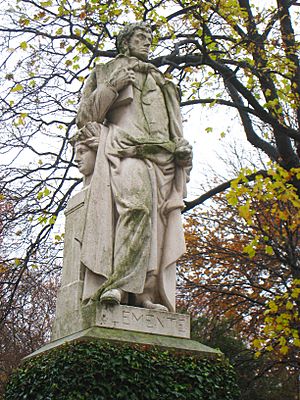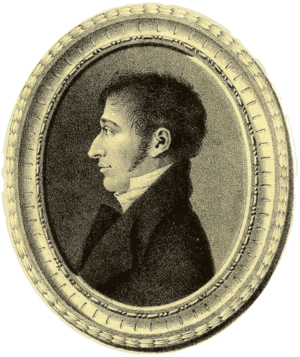Simón de Roxas Clemente y Rubio facts for kids
Simón de Rojas Clemente y Rubio (born September 27, 1777, in Titaguas, Valencia, Spain – died February 27, 1827, in Madrid) was a famous Spanish botanist. He is known as the "father of Spanish ampelography," which is the study of grapevines.
Contents
About Simón de Rojas Clemente y Rubio
His Early Life and Studies
Simón de Rojas was born into a large family with 15 children. Only six of them lived to be adults. His parents were Joaquín Clemente Collado and Juliana Rubio Polo. Simón was fourth in line to inherit the family's notary business, so he had little chance of taking it over.
When he was 10, he went to a seminary in Segorbe. After four years of studying humanities, he moved to Valencia. There, he continued his education and studied philosophy. He became an arts professor. He also studied church subjects and was very good at languages like Greek, Hebrew, and Latin.
However, Simón was more interested in natural sciences. He started collecting and classifying plants and animals. Around this time, another botanist, Antonio José Cavanilles, published a book about the plants of Valencia. This book made Simón even more interested in botany.
Starting His Work in Madrid
In 1800, at age 23, Simón went to Madrid. He wanted to become a professor of Logic and Ethics. He didn't get that job, but he did get a position at the Colegio de San Isidro. He also became a student there. He studied Arabic, Botany, Mineralogy, and Chemistry.
While studying, he met important people he would work with later. These included Casimiro Gómez Ortega, who was the head of the Madrid Botanic Gardens. He also met Mariano Lagasca y Segura. In 1802, Simón and Mariano published a book together called Introducción a la Criptogamia Española.
In 1802, Simón became a professor of Arabic. He met Domingo Badía y Leblich, also known as Alí Bey. Domingo was a traveler and spy who also loved Arabic and natural sciences. He convinced Simón to go with him on a trip to North Africa. Simón thought it was a science project, but it was actually a spying mission for a powerful Spanish leader, Manuel Godoy.
Travels and Discoveries
Simón traveled through France and England with Domingo Badía. During these trips, he collected and organized nine volumes of plant information. He gave these to the Botanic Gardens when he returned to Madrid. Domingo Badía left Simón in North Africa. However, Manuel Godoy paid Simón a monthly amount for four years. He also asked Simón to study the natural history of the old Kingdom of Granada.
For almost two years, Simón traveled around Granada, Jerez de la Frontera, and Sanlúcar. He collected samples of wild and farmed plants. He observed how farmers grew crops and noted the soil types and weather patterns. He also studied how plants adapted to their natural homes. The results of this work were stored at the Botanic Gardens in Madrid.
In 1804, he also traveled to Seville. In 1806 and 1807, he published several articles. These articles later became part of his important book, Variedades de la Vid Común que Vegetan en Andalucía, published in 1807.
This book came about after he met three well-known farming experts. They encouraged him to study ampelography, the study of grapevines. This was a new field in Spain. Simón became the leading expert on this topic in Europe.
In 1807, he returned to Sanlúcar to manage the Botanic Gardens. He made the gardens bigger by adding an experimental section. His goal was to grow every type of grapevine found in Spain there.
During the Napoleonic War

The Napoleonic Wars changed Simón's plans. He tried to stay neutral during the war. He could travel freely around Andalusia and to Madrid. In 1812, he settled in Titaguas.
According to his first biographer, Miguel Colmeiro, Simón worked on many science and community projects there. He wrote about the history of Titaguas and drew maps of the area. He also researched family histories. He taught children and adults how to identify different birds and plants. He even started a theater group and acted in plays.
After the war, he was asked to help with maps of the province of Cádiz. But he chose to become the Librarian at the Madrid Botanic Gardens. His friend Mariano Lagasca was in charge there. In 1817, they both organized collections of South American plants. These plants had been sent to Madrid by José Celestino Mutis.
Simón then edited an old farming book called Agricultura General by Gabriel Alonso de Herrera. He wanted to update the 1513 version with more modern science. He wrote a new introduction and added sections on different types of wheat and how to grow cotton. Most importantly, he added details about grapevine types, how to grow them, and the main wines made in Spain.
Later Years and Legacy
In 1820, when Riego brought back the Cortes of Cádiz (a type of parliament), Simón supported him. He was chosen to represent Valencia. He joined committees on Health, Agriculture, and Public Health. He only spoke once in parliament. He suggested creating an experimental farm in Sanlúcar de Barrameda.
Simón's health was getting worse because he had yellow fever in the past. He took time off to recover and went back to Titaguas in 1821. He stayed there for five years. He kept collecting information for his Historia Natural de Titaguas. He also continued to add to his collections of plants, insects, and animals. He started studying beekeeping and made notes in books and notebooks.
He returned to Madrid in 1826 to finish some of his many unfinished works. He died there on February 27, 1827.
Simón de Rojas Clemente is remembered for his important work in planning and collecting different grapevine types. His work helped create the "Plano de Flor" collection.
See also
 In Spanish: Simón de Rojas Clemente y Rubio para niños
In Spanish: Simón de Rojas Clemente y Rubio para niños


